Episode 02
The G Word: Gentrification
Continuing the conversation with David Favela of Border X Brewing in San Diego, Eunice and Erika confront the hard truths about zoning, revitalization, and community engagement. Then David offers his strategy for gente-fication, a more human approach to community development that requires both perspiration and perseverance.
Show Notes
In this episode, you heard David Favela offer his definition of gentefication:
“Gentefication is really about people—hence the word gente—and it’s really thinking about these beautiful, messy things we call human beings and how we integrate them into the economic and the built environment….how do we preserve and grow with the people that are already there?”
He also breaks down the three rules of gentefication:
- Serve the people who are already there, not future high-paying customers who may displace existing residents.
- Tell the stories of the community and the people who have built and cared for the neighborhood. Surround residents with reminders of their cultural context and the history of the place, including the stories of the oppressed.
- Create an “escalator” for young entrepreneurs with great ideas, creativity, heart, and hustle to take risks, seize opportunities, and succeed.
Note that David’s take on gentefication is one among many in Latinx and Chicanx communities. You can get a taste of the complex conversation in, to name just two examples, the 2020–21 Netflix show “Gentified” and the acclaimed 2021 book by poet Antonio de Jesús López.
Gentrification refers to the intersection of urban development and class dynamics. Ruth Glass, an urban planner and key figure in urban sociology, coined the term in 1962 to describe the displacement of London’s poor for the creation of upper-class enclaves.
In the episode, Eunice shares a definition from a study in Nathaniel Chapman and David Brunsma’s 2021 book Beer and Racism:
“Gentrification […] coincides with the displacement of current residents and businesses, who tend to be poorer and from racial and ethnic minority groups.”
The impacts of gentrification are human scale, so we’re throwing in the American Psychological Association’s definition as well:
“The physical upgrading of neighborhoods and housing that accompanies an influx of wealthier residents. It is theorized that an important adverse effect of gentrification is the displacement of many long-term residents who can no longer afford to live in the gentrified area.”
In the episode, you heard Eunice contrast gentrification with revitalization.
The Samuel Centre for Social Connectedness, a leading Canadian research and advocacy nonprofit dedicated to community building and relationships, makes the distinction crystal clear:
“Revitalization means reinvesting in the existing community. It involves reinforcing social networks, neighbourhood services, and local businesses. It involves diversifying but maintaining the neighbourhood’s character; and ensuring mixed income housing development to avoid displacement. In contrast, in gentrifying neighbourhoods, the community transitions to an exclusive community, inaccessible to those who once called it home.”
A 2017 study in Untapped: Exploring the Cultural Dimensions of Craft Beer found no evidence entirely consistent with the common narrative link between gentrification and craft brewing. Rather, it found a link between an influx of lower-to-middle income urban creatives and the introduction of a craft brewery.
The gateway Erika and Eunice passed through on their Barrio Logan tour with David was Chicano Park, a beacon for San Diego’s Mexican American community. It is known for its murals and as a meeting place for Latinx organizers. It is now a National Historic Landmark.
The murals range from colorful portraits of Mexican painters (Frida Kahlo, Diego Rivera, José Clemente Orozco, and David Alfaro Siqueiros) to empowering statements such as “All the Way to the Bay,” the rallying cry of the Ronnie Trujillo–led campaign to extend Barrio Logan all the way to the waterfront.
According to Mario Torero, one of Chicano Park’s original muralists, these murals are also symbols of the political struggle the neighborhood experienced in the ’70s:
“We told the story of the colors and dreams of our ancestors, painting new faces of our sad and glorious history on the pillars and screaming in full rage.”
David Favela is founder and CEO of Border X Brewing and Director of the federal Build to Scale initiative at the University of California San Diego.
This episode features music courtesy of Epidemic Sound:
“Vals del Carnaval” by Vendla
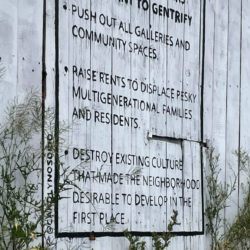
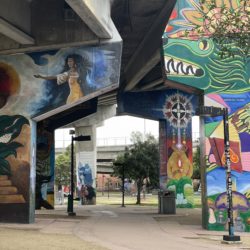
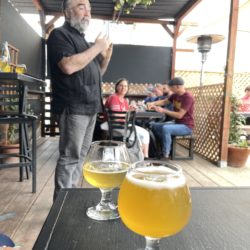
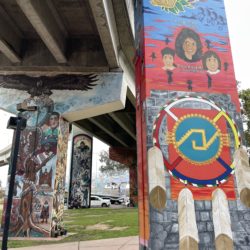
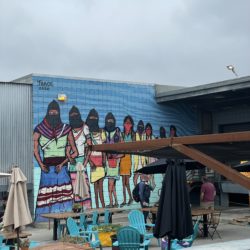
Transcript
Eunice Wong: Inhabit is a show about power, the power, the power of design.
[Street noises from Barrio Logan and “Vals del Carnaval” (Instruments stem only) by Vendla/Epidemic Sound fade in.]
Erika Eitland: Eunice I can still remember the first time we walked to Border X Brewing, because we were like a little line of ducks from the San Diego Conference Center. You know, like, okay, we’re gonna go on this brewery tour. And yet they’ve have us walking along this busy road. There’s a dusty sidewalk like you could have like tumbleweeds blowing by. The coastline is so close. And there’s this complete disconnect. There’s industry, there’s fences, there’s theoretically beach just on the other side, but there are no sea breezes.
Eunice Wong: I know I was like, “We were promised a brewery! Where the heck is the beer?”
Erika Eitland: And then you turn the corner into Chicano Park, and you’re shaded, and it feels like this oasis under overpasses. And you’ve got the 5, and the 75. And it’s noisy, but you’re like so happy to be in this space.
Eunice Wong: I remember just walking, it’s essentially a gateway under these overpasses and ta-da! There’s these giant beautiful murals… they were like these beautiful magentas, teals, and blues and greens. They were extending up these, you know, what are typically, ugly highway bents. But they look like they’re they were capturing the history, and the legacy, even up to today. So, it reminded me of art being used, you know, as protest, as reclamation of space. And it was just really powerful to see, as we were entering Barrio Logan.
Erika Eitland: You could tell that the ground had been like fought after, and it was this moment where I was just like, “oh… we are visitors here”. Like you and I are on a brewery tour. And it just made me wonder like, what were we missing? What could we not see?
[Barrio Logan street noise fades out. “Vals del Carnaval” intensifies and then fades out.]
Erika Eitland: I’m Dr. Erika Eitland.
Eunice Wong: And I’m Eunice Wong. This is ‘Inhabit Summer Jam’. Today we’re talking about the need for designers of our built environment to embed and engage the community in the design process. And as planners or at least for myself, we fear the G word, gentrification. So, we’ll get into the messiness of all that. What role does the power of design have in that mess?
Erika Eitland: Alright, hold them. When I hear gentrification from a public health perspective. I am thinking forced migration, disinvestment in intergenerational communities, increased stress for existing residents, or just widening disparities. So, Eunice, I think we need to let everyone in on why we think this San Diegan brewery is a part of that story.
Eunice Wong: Okay, so from a design perspective, part of why these breweries are in areas like this is because of what I talked about last time, zoning and land use. So, breweries take opportunities of adaptive reusing buildings or old industrial buildings that have this cool look to them. You know, they provide jobs. They’re located in areas where there’s space for that big, clunky beer equipment and machinery, they bring in investment. But what are the stakes of change? What are the stakes for the people living there?
Erika Eitland: As you’re like explaining this, this sounds like my town. So, it’s one of the poorer neighborhoods in Massachusetts, it’s pretty rural. But we have all these old mill buildings filled with asbestos, delicious. And yet, we have this beautiful access to the waterfront. We’ve spent hundreds of thousands of state dollars to remediate these buildings to make them appropriate for the brewery. And so, there’s this question and tension, “Okay, is it going to bring an investment? Or is it going to make it less affordable for folks to live here?”
Eunice Wong: This is why I fear the “G word” like the boogeyman, and I think the line between gentrification and revitalization is way messier than we think.
Erika Eitland: And I don’t know, you probably have a better definition than I do. But what is the real definition of gentrification? Just so we’re all on the same page.
Eunice Wong: Gentrification is not just change. It’s not just about the hipsters and the beanies moving into these neighborhoods. But it’s also when it coincides with displacement of current residents and businesses who are typically poor and made up of racial or ethnic minority groups.
Erika Eitland: Interesting. I mean, for me, and my little nerd brain, I’m like, let’s talk indicators. But I think we’ll talk about that next episode. So, I don’t know, where do we go from here?
Eunice Wong: A lot of gentrification happens because there’s a lack of policies or tools, like zoning to value community input or provide true access to housing. And it lacks respect. It lacks respecting what the community needs today versus trying to anticipate or even force onto the community what we think they want.
Erika Eitland: In public health, we call this ‘parachute science’ where you go in, you drop some knowledge, and then you leave. And I think this is a great opportunity for us to bring back David Favela, the CEO of Border X Brewing, because he’s really talking about how the real work takes both perspiration and perseverance. I asked David, “What the community’s reservations were when he entered the community. How did he earn their respect? How did he overcome challenges?” Here’s his answer.
David Favela: Such a critical question. Like I said, Barrio Logan has been here for generations. And as part of that they are very protective and defensive about what goes on in their community. And they have ways of controlling what goes on in their community, everything from civil disobedience to other things. And very interesting. So we didn’t have a lot of money when I opened up the tap room here, and I did a lot of the work. I’m very handy. I do construction, carpentry, all kinds of stuff. And so, I would be there, as I mentioned, covered in concrete dust or whatnot. And when some of these elders would come by, and I’m talking people in their 70s, and 80s, and would just randomly stop me, I’m like, okay, I talked to them. But they were vetting me. They were okay, who’s that guy? What’s he doing? What’s his interest? Oh, no, he’s doing all the work. You know, he’s told us about his vision, his dream about opening up this brewery. And, and, you know, without knowing it, if I had shown up with just bags of cash and hired a bunch of contractors and sat there in a suit just supervising people do the work. Yeah, I think it would have backfired. To be honest, I think I might have been run out of the neighborhood, to be honest. But I think there was a certain amount of respect, that they saw that I was there, and that I came from as humble origins as anyone else. And they respected that, that was really, I think, the foundation of why I was allowed to open in the neighborhood. But then I think I’ve proven myself through my actions and what I what I tell people, and you know, and explain to them, why we come here and why we do the things that we do and, and why it matters. Because I would say that there was a tipping point, where because it’s such an activist community, that there were a lot of people said, no, no, no breweries are all about gentrification, you’re just a shock troops of the real estate agents. And soon this whole place will be transformed, and we’ll all be displaced. And I met with him. I said, “Don’t throw rocks at my place. Don’t spray paint. Let’s meet. Let’s talk.” And I think you know, after having discussions, saying, look, and my basic point has always been the same.
Erika Eitland: How many meetings did you have?
David Favela: Oh, my God.
Erika Eitland: Like, how long did this go on? Cause I feel like you’re like going through this, but I’m like, nothing happens in one good meeting.
David Favela: Like no, it never. It’s really about consistency. And walking the walk. Yeah, because anybody can talk the talk. It’s really been there. And they see that. And I think there’s a tremendous amount of respect. I mean, I had meetings from, like I said, with these elders, to even one day, I remember coming back here and I, there was a few gentlemen at a table. And I had asked them to please if they could be quiet because we were doing an interview or whatever. And everyone was really awkward. And I was like, Oh, shoot. Oh, no. And I remember that they were asking me questions about “Why did you come here? What is going on?” And I kind of suddenly snapped into focus that I was talking to what are called the ‘shot callers’ of the neighborhood, the people who control mostly everything.
Erika Eitland: Yeah.
David Favela: And an incredible peace came over me. No fear whatsoever, which was unusual. I should have been scared. But I was just upfront and honest about it and I said, “Look, I think this is really important for our community. Yes, it is changing, but I think if we can control the change, if we can be part of the change, I think we all have a role to play.” And, and you know that that was enough for them.
Erika Eitland: So, David refers to Barrio Logan as an activist community, and Eunice you and I were there almost 52 years to the day after local residents rose up in April 1970 and said “enough!”, the city had introduced junkyards, industries, building freeways, and stripping away homes. And the community just really wanted a park. So, when they saw construction equipment and plans to build a ‘California Highway Patrol substation’, this was their deal breaker. They had a sustained effort to protect Chicano Park from disruption. Fifty-two years later, it is a National Historic Landmark.
Eunice Wong: Wow
Erika Eitland: Knowing this history and legacy, I would be terrified to be in David’s shoes. So I think this is the part of the episode where we introduce community engagement, you as my designer counterpart, like, where does it come into this process?
Eunice Wong: Oh, yeah, community engagement is such a core piece of the design process. And you know, by definition, it’s about seeking feedback from the users or community. But I think what David is getting to when he says to the community, you know, “let’s meet, let’s talk.” Engagement is also about gaining trust from the community, which I think is harder than just asking people, you know, “what color do you want your bike lane to be painted?” Or, you know, “do you want a swingset or a splash pad in your park?” It’s at the end of the day, I think about respect, respect is also taking responsibility when we go into a neighborhood. It’s admitting, you know, we don’t know it all. We know somethings. But you know, you tell us what you think and really hearing what people have to say
Erika Eitland: That authentic listening is something that as public [health] scientists, we refer to as qualitative methods.
Eunice Wong: Of course.
Erika Eitland: We’ve got focus groups, and we have surveys, and we have probing questions. And it is about trying to authentically listen and bring people in and take in information in a way that is systematic, so that you don’t miss anything, you want to make sure you get to the saturation point. That can only happen when you are willing to go to the elderly person in the affordable housing unit who has no Wi-Fi and make sure they have a paper survey because they can’t get the electronic one.
Eunice Wong: Oh, yeah, that’s meeting people on their turf, what you’re saying. It’s not just one meeting, it’s probably multiple meetings, like David said, it’s about exhausting, you know, all avenues to engage and then really integrating what was heard into the work as we refine it. What does that look like? I’ve worked on projects before where we’ve actually translated materials into different languages based on the people in the community, we have done the extra work to make sure documents are accessible for screen readers, or that the color contrast is right for people who are visually impaired. Or once, I remember, we had a lot of families in this neighborhood that we wanted to engage. And we’re like, instead of just engaging just the adults, why don’t we make a fun scavenger hunt to also get the kids engaged. So it’s really about tailoring the process and approaching our work with a bit more humility.
Erika Eitland: One thing that touches me from David’s conversation with us is David is here for that humility. And he talks about the importance of storytelling, and really what is lost if we don’t have authentic community engagement.
David Favela: I feel like there’s a serious lack of storytelling about our communities. You know, people really don’t understand Barrio Logan, I didn’t understand Barrio Logan until I came here, worked here, learned, you know, met people talked about history that I truly started understanding Barrio Logan, and its unique history. But there are stories all across the United States. And the stories that tend to be told are the ones that, are… how shall I say it, the more dominant stories, maybe perhaps. I’ll give you an example. When we opened up our brewery in the City of Bell, right across our street, they’ve preserved the Victorian home of the original Bell Pioneer Family. And you’d like to think, based on the stories being told there, that they came to this empty land, and through sheer hard work and hustle created something out of nothing. And it’s like, no. Actually, there were the Kumeyaay – Well, in there, there was a different tribe, but there were Native Americans. And then after the Native Americans, there were Mexican Ranchito families who had adobes that were preserved, that were razed to the ground and something built on top of it, but you know, that is repeated over and over again. I mean, we looked at Escondido, which is in the north county, and I was looking at a place to potentially open another brewery. And it was this old little corner store called Lopez Market. And it’s where all the farm migrant workers would cash their checks, would buy their tortillas… I mean, I mean, going back for a long, long time, there was even a clandestine poker game in the back room. And it’s so symptomatic, I think, especially in urban planning, that that was razed to the ground. I was trying to save it and I was going to build a brewery around and just use that as a platform to tell the story about migrant workers in that city. Who, frankly, were the economic engine. Yes, the ranchers own the properties, but the people who work the land, no one’s telling their stories. And in the ultimate of ironies, the planning group of that city had a brilliant idea. They were going to redevelop that whole section. And they’re gonna call it the Mercado District. And it was going to be celebrating the colonial, romanticized past of California. And it just felt like a stab in the heart. It’s like, because it’s being standardized in a way that’s romanticized, nostalgic, and totally removed from the Latino guy who’s walking down the street, whose parents or grandparents used to be migrant farmworkers. There’s no connection between him and what they’re trying to do. So we’ve been kind of, there’s this chapter of just the common person, the hard working person that’s helped build this country, and they’re invisible.
Eunice Wong: Wow. Power has a way of making some people invisible. And when you’re talking about power, it’s inevitable. There are those that benefit – the winners – and then there are the losers. That’s what makes it gentrification and not revitalization is that there will be losers. There will be displacement when investment is not done carefully. When design is not reflective of all stakeholders. When culture feels erased or watered down. And whether you’re a winner or a loser? That depends if you benefit. If you have money, agency, ability to stay in the neighborhood, you benefit from gentrification, you’re able to afford, you know, the triple hopped IPA or the $7 latte, while others get completely displaced and priced out of their neighborhood. So it’s not just about you know, preventing any change in the neighborhood. But how do we support a community that feels authentically theirs? How do we unlock these “Ratatouille moments”? For us, it’s inclusion of culture. It’s storytelling. It’s passing the mic back to the community and making space for what’s already there.
Erika Eitland: You may have all thought that the G word for this episode was Gentrification, but the G word is ‘Gente’. People. The Spanish word for people. For this Chicano neighborhood, the Gente are at the center of this “Ratatouille moment”. But that G word will be different in different places. Revitalization must be different block by block, city by city, whether you’re Bengali, Ghanaian, Carioca or Kiwi.
Eunice Wong: That right there – that’s the heart and the soul of design. So to your point, Erila about people, about Gente, let’s decolonize our minds, like David said. Think about the people that built this neighborhood. Let’s have those hard conversations about the uncomfortable parts of history we need to learn about, in order to prevent us from making the same mistakes. So to continue my rant about power, power makes people who have privilege think that when they benefit materially, they are winners, but they’ve actually traded culture and community, for what? Comfort and coolness? power makes people feel like there are winners and losers, when in fact, displacement is everyone’s loss.
Erika Eitland: And so on the other end of our walk through Chicano Park, through the cathedral-like murals and the dusty streets, David introduced this radical concept that was new to us, but has been in a Latinx community for a while. And it really resonated with us and everything we care about in our work.
David Favela: Gentefication is really about people, hence the word Gente. And it’s really thinking about these beautiful, messy things we call human beings and how we integrate them into the economic and the built environment. And one of the things as these communities evolve is how do we preserve but grow with the people that are already there? And so the first of the three rules of gentefication is really when you come into the neighborhood with a business, which is very influential, they are cultural merchants, as well as being you know, businesses. You have to serve the people that are there, that has to be the first thing. If you’re building a business in this community hoping that one day they’ll all be displaced by people with higher incomes, who can afford your Tiffany lamps for $10,000, then that’s the opposite of gentefication, that’s just taking advantage of low rents in order to sell whatever it is that you’re selling. So that’s number one. Number two, is that your business be an active part of that storytelling of the community, of the people, so that as people grow within this community, they are surrounded by positivity, reminders about the cultural context of this physical space, and these buildings that we play, grow up around. And so we really don’t want to erase the history of a place. And more importantly, we want to tell the stories of people who frankly, have been oppressed or haven’t had their stories told. So I think gentefication has to go back to that storytelling. And thirdly, you really have to create what I call an escalator for anybody who has a great idea, the creativity to create a product or service, and the heart and hustle to make it real. And because we know for a fact that most people of color or low income, underserved communities don’t have deep capital reserves, and we know that they’re not going to get a lot of big loans, then you create those opportunities for them. Where they’re not only taking smaller risks. And perhaps instead of renting a two- or three- or four-thousand square foot retail location, start off that jewelry shop with, you know, 200, 300, or 400 square feet, and something that they can afford. But more importantly, when they’re embedded within this community of other entrepreneurs, it almost creates a self driving dynamo of entrepreneurialism. Because entrepreneurialism can be a very lonely, scary and difficult path to take. You almost have to be a little bit crazy. But when you’re surrounded by people who are a little bit crazy too, in a good way, it actually gives you courage to take those risks, to take those chances, and hopefully succeed.
Eunice Wong: That was beautiful.
Erika Eitland: That was beautiful. And I don’t really think there’s anything else to say. So we’ll see you next time.
[“Vals del Carnaval” (Full Mix) by Vendla/Epidemic Sound fades in.]
Erika Eitland: Inhabit is a production of Perkins and Will. I’m Erika Eitland.
Eunice Wong: And I’m Eunice Wong. Check out our show page at Inhabit.PerkinsWill.com for the show notes, music and links to all of the resources and references we mentioned. Follow us on Instagram @perkinswill.
Erika Eitland: The scrappy team is led by Dr. Lauren Neefe, our executive producer who also edits the show. Shout out to Julio Brenes for the illustrations you see on our website, and to our research assistant Olivia Fox. Music by Epidemic Sound.
Eunice Wong: A special thank you to David Favela for inviting us with open arms to Border X Brewing and sharing his inspiring story with all of us. We’re so grateful for your time.
Erika Eitland: And thanks to our advisory board for being straight with us once again. Casey Jones, Paul Kulig, Yehia Madkour, Angela Miller, Rachel Rose, Kimberly Seigel and Gautam Sundaram.
[“Vals del Carnaval” gets louder for 15 seconds and then ends.]
Perkins&Will chorus: People Places Power Design Change Now
[Sound ID: Snap echoes into an empty space.]
